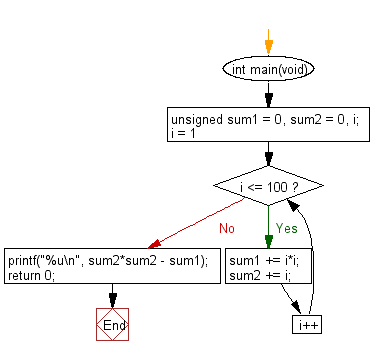C Exercises: Find the difference between the sum of the squares of the first one hundred natural numbers and the square of the sum
C Programming Practice: Exercise-22 with Solution
The sum of the squares of the first ten natural numbers is,
12 + 22 + ... + 102 = 385
The square of the sum of the first ten natural numbers is,
(1 + 2 + ... + 10)2 = 552 = 3025
Hence the difference between the sum of the squares of the first ten natural numbers and the square of the sum is 3025 − 385 = 2640.
Write a C programming to find the difference between the sum of the squares of the first one hundred natural numbers and the square of the sum.
C Code:
#include <stdio.h>
int main(void)
{
unsigned sum1 = 0, sum2 = 0, i;
for (i = 1; i <= 100; i++) {
sum1 += i*i;
sum2 += i;
}
printf("%u\n", sum2*sum2 - sum1);
return 0;
}
Sample Output:
25164150
Flowchart:

C Programming Code Editor:
Contribute your code and comments through Disqus.
Previous: Write a C programming to find the smallest positive number that is evenly divisible by all of the numbers from 1 to 20?
Next: Write a C programming to get the 1001st prime number?
What is the difficulty level of this exercise?
C Programming: Tips of the Day
C Programming - Why do all the C files written by my lecturer start with a single # on the first line?
In the very early days of pre-standardised C, if you wanted to invoke the preprocessor, then you had to write a # as the first thing in the first line of a source file. Writing only a # at the top of the file affords flexibility in the placement of the other preprocessor directives.
From an original C draft by the great Dennis Ritchie himself:
12. Compiler control lines
[...] In order to cause [the] preprocessor to be invoked, it is necessary that the very first line of the program begin with #. Since null lines are ignored by the preprocessor, this line need contain no other information.
That document makes for great reading (and allowed me to jump on this question like a mad cat).
I suspect it's the lecturer simply being sentimental - it hasn't been required certainly since ANSI C.
Ref : https://bit.ly/2Mb8OVZ
- New Content published on w3resource:
- Scala Programming Exercises, Practice, Solution
- Python Itertools exercises
- Python Numpy exercises
- Python GeoPy Package exercises
- Python Pandas exercises
- Python nltk exercises
- Python BeautifulSoup exercises
- Form Template
- Composer - PHP Package Manager
- PHPUnit - PHP Testing
- Laravel - PHP Framework
- Angular - JavaScript Framework
- React - JavaScript Library
- Vue - JavaScript Framework
- Jest - JavaScript Testing Framework
